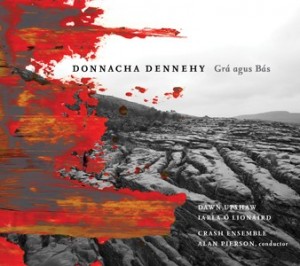
It’s not often these days that I am grabbed immediately by modern classical works. But Donnacha Dennehy’s latest release, Grá agus Bás, stands as a firm exception. Of course, there are plenty of pieces I enjoy from an intellectual standpoint, like Steve Reich’s Four Organs. I find that as the piece evolves, so does my understanding of it. But unlike Dennehy’s work, there isn’t anything about it that really strikes me in the first few seconds.
Dennehy’s titular piece is a twenty-five minute odyssey that grabs the listener and maintains that grip right to the end. Its sonic landscapes are a barren depiction of Dennehy’s native Ireland, and they are reminiscent of the spectral works of Murail and Grisey particularly in orchestration. The piece opens with Irish folk singer Iarla Ó Lionáird and develops slowly but gorgeously. While the presence of minimalist traditions is undeniable, so is Dennehy’s transcendence of the genre’s limitations. The strings provide a rippling sound which allows Ó Lionáird’s voice, punctuated by the winds, percussion, and the perhaps unexpected electric guitar, to soar.

I know little about the traditional Irish music “sean-nós” to which Dennehy attributes his inspiration for his piece. Still, the album’s liner notes explain how he drew lines from two sean-nós and manipulated them to form the text for Ó Lionáird. There are more hints of spectral music here as he explains how he used pitch-analysis software to analyze the singer’s voice and derive melodic material from the overtone series of the bass.
Also included on the new release is a recording of That the Night Come, a more recent song cycle based on W.B. Yeats’ poems. The songs were written for American soprano Dawn Upshaw, remembered by many for helping rocket Henryk Górecki’s third symphony to fame in the early 90’s. Their character is very different from “Grá agus Bás;” the pieces are driven along in a quasi-minimalist manner with pulsating metric shifts. The piece noticeably lacks the electronic alterations contained in “Grá agus Bás” which it may be better off without. Yeats’s beautiful texts, paired with the pure voice of Upshaw, result in a very organic sound. The presence of an accordion in the cycle is curious but not unpleasant.
The album as a whole is remarkably solid. Although “Grá agus Bás” is undeniably the powerhouse track, the six songs comprising That the Night Come are actually the bulk of the album and they do not feel simply like filler tracks which increase the length of the CD.
"News related to the modern world of classical music."





